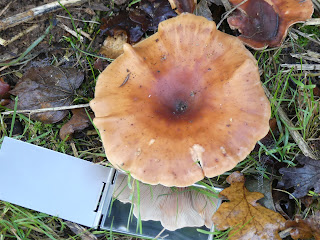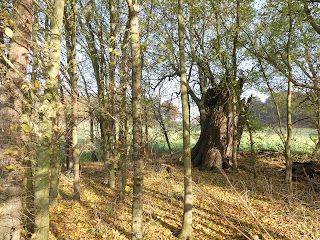As it was an organised event we met away from the usual car park and then got underway with Alan, David and Laura.
We had a cold but gloriously bright morning for it and started near where there stood a beautiful country house and orangery overlooking the lake. My wife and I often walk around the area but we usually walk near the lake so the walk headed into a part that we don't often frequent
We stopped and looked at lots of trees and fungi so I've picked out a few notables. This unusual Sycamore appears to be growing out of an old dead stump, perhaps a windblown seed?
This Beech loving fungi is Brittle Cinder (Kretzschmaria deusta) and Alan explained that this causes spalting through the wood which makes for attractive carved objects, similar to this lovely spalted firewood project that I've recently finished albeit with Birch.
We stopped to measure this Sweet Chestnut's girth which came out at 5.23 metres which is apparently a decent measurement in veteran terms.
In between the tree observation we did find several mushrooms, maybe a Frosty Funnel (Clitocybe phyllophila) at the top, a Russula in the middle and an Amanita below?
This mighty Pendunculate Oak was a sight to see, even though the tip was missing due to a lightning strike. It's age is estimated to be between 450-500 years (to put that in context it probably would have germinated during Henry VIII's reign). It's girth was 7. 94 metres which puts it in the upper echelons of veteran trees.
We spent a bit of time in this wooded area and got given information about how trees adapt to old age and their environments, for instance the three parts to an Oak's life cycle. The picture (above left) shows a tree that has developed 'ramshorns' as it attempts to grow over a wound.
As we emerged from the wooded part of our walk we entered an area that my wife and I were more familiar with, or so I thought. As impressive as the mighty Oak was I was taken by the presence of two stands of young English Elms (decimated across the country by Dutch Elm disease) with the mother tree that they probably suckered from. I'd not noticed them before and when we were asked what variety it was I was reticent to say.
Mistletoe features prominently in the park but I noticed a small but perfectly formed specimen at head height, perfect for a quick peck on the cheek. Nearby was a naturally occurring Lime, as opposed to a planted one. The Lime was the sixteenth indigenous tree variety I saw, I say indigenous because the area around the house was landscaped and as an example there are non-natives such as a small stand of False Acacias nearby.
And some more cheeky specimens, maybe Milking Bonnet (Mycena galopus) at the top, and possibly another Bonnet of some sort (growing on the measured Sweet Chestnut) in the middle? And Turkey Tails (Trametes versicolor) at the bottom?
One particular example had grown round a lot of barbed wire with possibly common inkcap mushrooms below. Even though the trees had been pollarded they were still impressive and apparently it prevents trees from ageing as quickly as a maiden (untouched) tree.
Here we have a good example of an Oak healing over the spot were a branch was removed but the tree is also showing signs of acute oak decline, a disease of more mature trees.
And my wife was pleased to spot an example of a Beech tree's 'ramshorn' repair of a wound, which was later confirmed in a talk about this stand which also included a monolith tree which is basically just the trunk which is left to benefit nature. We also saw a good example a little distance away of brown rot which produces punky wood, often used to smoke hides with.
I spotted these parasol mushrooms which turned out to be Shaggy Parasols (Macrolepoita rhacodes). Jane, one of the course attendees, helped out with the ID saying that they have white stems as opposed to Parasols (Macrolepiota procera) which have scaley stems.
We chanced upon a decent sized Artists Bracket Fungus (Ganoderma applanatum) which often favours Beech and apparently likes to grow low down, whereas the Beefsteak Fungus (fistulina hepatica) tend to be a little higher on the Panshanger estate Oaks, a spent example of which is shown above right. it was pointed out that if a bracket fungus is vertical on a fallen tree you know it came down with said tree because brackets grow horizontally.
We had completed a three hour meandering circular walk and the last thing I saw of note was a Common Mallow (Malva sylvestris) that had snapped close to the ground and yet still had two decent blooms showing in mid November.
What an enjoyable wander we had been on, I've learnt some stuff that I previously didn't know which is always a good thing but it also shows you how much you don't know too!
By the way, the sixteen varieties of indigenous trees noted today were Pendunculate Oak, Hornbeam, Beech, English Elm, Lime, Holly, Alder, Silver Birch, Cherry, Larch, Willow, Sweet Chestnut, Yew, Elder, Sycamore and Scots Pine.











































